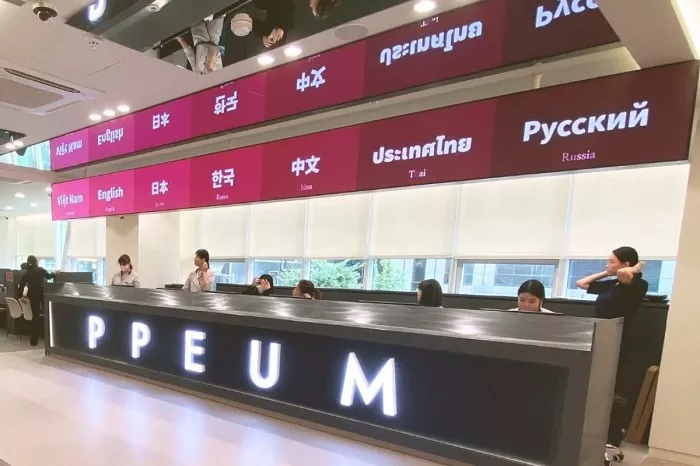South Korea has long been known for its strong exports in cars, ships, and semiconductors. In recent years, cultural exports like K-pop, Korean dramas, and food have also captured the world’s attention.
Now, cosmetic surgery is emerging as a powerful new attraction for foreign visitors. In 2023, more than 114,000 people traveled to Seoul for plastic surgery procedures.
One of them was Nguyen Thi Huyen, a 26-year-old marketer from Vietnam. She underwent facial contouring surgery, including cheekbone and jaw reduction as well as chin reshaping.
“Korea is famous for plastic surgery. Many young Vietnamese women want to look like K-pop stars such as Jang Won-young or Karina,” she said.
Nguyen is part of a growing trend. South Korea welcomed around 1.17 million medical tourists in 2023—the highest on record—according to the Ministry of Health and Welfare.
Dermatology treatments made up the majority at 56.6%, with plastic surgery accounting for 11.4%. The number of plastic surgery procedures increased by over 24% compared to the previous year.
As demand grows, Korea’s medical tourism industry is booming. Market research firm IMARC Group estimated its value at $1.9 billion in 2023. By 2033, the market is expected to reach $3 billion, with annual growth projected at over 5%.
Dr. Choi Soon-woo, chief surgeon at View Plastic Surgery in Seoul’s Gangnam district, has witnessed this growth firsthand. “Since COVID-19 ended in 2022, the number of foreign patients at our clinic has increased by 20 to 30 percent each year,” he said.
His clinic now serves thousands of international patients annually from countries including the U.S., Japan, Russia, Indonesia, and China.
Choi noted that wealthier Indonesians are seeking better surgical options abroad due to limited healthcare infrastructure at home. With foreign patients now making up the majority of the clinic’s revenue, the center employs around 60 coordinators who speak 10 different languages to assist patients from start to finish.
For international patients, aftercare is critical. Many cannot return for follow-up visits, so clinics like Choi’s offer services that help speed up recovery and reduce complications.
One satisfied patient is Natsagdorj Namuun, a 30-year-old freelance model from Mongolia. She underwent rhinoplasty in 2022 and said she was impressed by the attentive care. “I’d recommend surgery in Korea to anyone. It’s worth the money,” she said. After liposuction, she received massages to ease recovery and detailed instructions from staff.
While surgery in Mongolia is cheaper, many Mongolians choose Korea for its high success rate, which reduces the need for repeat procedures.
Choi admitted that Korea is not the cheapest option. However, many patients still prefer it due to the country’s high medical standards. “We often see people who had complications from surgeries done in other countries,” he said. “Their success stories in Korea are widely shared on social media.”
The Seoul city government is also supporting this medical tourism boom. Lee Yun-hwa, a manager at Seoul Medical Tourism, said they partner with 180 local clinics to help international patients book appointments, get consultations, and manage travel logistics.
According to Choi, current trends among foreign patients include facelifts and skin-tightening procedures. These are now more popular than breast augmentation and facial contouring, which used to be common among younger visitors. Skin-tightening procedures, in particular, require precise techniques to avoid scarring—an area where Korean doctors excel.
Seoul also stands out in complex surgeries such as double-jaw procedures and facial bone reshaping, which are less available in other countries.
Social media plays a big role in promoting Korean cosmetic surgery. Japanese tourists, for example, often decide to visit after reading reviews and stories on platforms like X (formerly Twitter). “Advertising helps, but word of mouth is what truly drives people to us,” Choi said.
However, he expressed concern that K-pop’s global influence might be waning. “Many American patients come because surgery is cheaper here, but K-pop also draws them in,” he said. “These days, things have slowed down. I worry because interest rises when new K-pop stars become popular.”
Choi recalled how the global popularity of BTS boosted business before the group entered military service. “There was a noticeable drop afterward,” he said.
Natsagdorj said she was first drawn to Korea through its music and pop culture. “I grew up listening to BigBang and Girls’ Generation. Korean dramas are also huge in Mongolia,” she said.
Experts say Korea should expand beyond cosmetic surgery to stay competitive in the global medical tourism market.
“Plastic surgery is Korea’s main attraction, but it’s time to broaden our vision,” said Chun Myung-sook, a professor at Konyang University. She believes the future of medical tourism lies in wellness and stress relief.
“Korea should develop health programs that go beyond surgery,” she said. “Other countries like India and Nepal offer wellness tourism. Korea can do the same by blending mental health and cultural experiences.”
Related topics:


